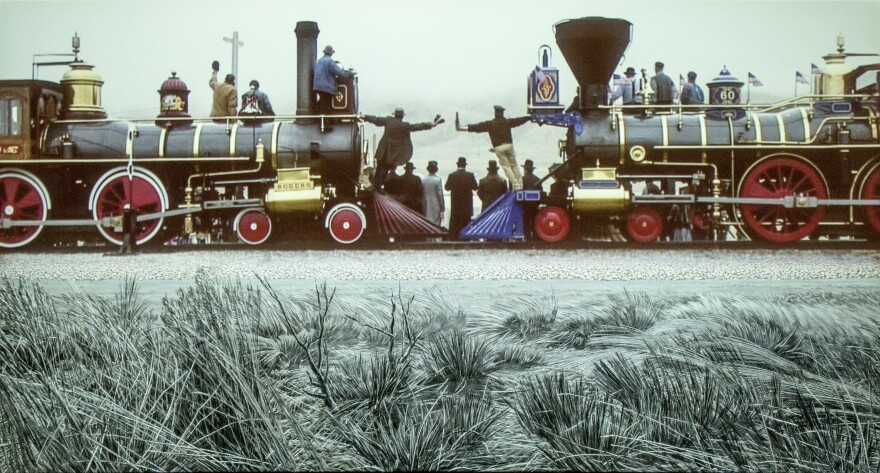The late 1800s brought thousands of Chinese immigrants to the West in search of better lives. Many participated in the construction of the Transcontinental Railroad. For the 150th anniversary of that engineering feat, artists have memorialized the contributions of those often forgotten Chinese immigrants. KUNR’s Paul Boger spoke with Holly Hutchings about the exhibit.
The names of some 1,200 once-unknown Chinese workers who lost their lives constructing the Transcontinental Railroad are being highlighted in an exhibit at the Nevada Museum of Art. Artist Zhi Lin and others aim to give names and remembrance to those workers.
Lin has spent much of his career creating multimedia works that display the sacrifices made by these immigrants, who were largely overlooked and treated unfairly as they labored to join the East to West. He says the workers were paid half of what their white counterparts made and lived much differently--the Caucasian workers resting in train cars while the Chinese men were made to sleep in camps outside on the side of the tracks.
Railroad companies also kept shoddy records of the thousands of immigrants, and in their deaths, many of their names were lost forever.
“The Chinese workers never recorded their names," Lin said, "or the railway companies never tried to track the Chinese workers as individuals.”
Around 20,000 Chinese workers blasted rock and laid track to complete the railroad. The workers suffered greatly in the Sierra during the bitter winter months of 1868 and 1869. They endured avalanches, explosions and frigid winters as they carved tunnels through the mountains near Donner Summit and the surrounding range.
The disparities between white and Chinese workers were glaring. Chinese laborers made less money, worked longer hours and had to pay for their own lodging and tools. Photos from that time usually only highlight white workers. The artists in this exhibit aim to draw the immigrants back into history.
Zhi Lin is an art professor at the University of Washington. He’s a trained printmaker whose work became more political following the 1989 Tiananmen Square massacre. He says that in this exhibit he highlights the nameless, faceless Chinese workers of the Sierra Nevada. Lin has made his canvases, watercolors and a video installation in an effort to illustrate the terrain the Chinese worked in and the hardships they faced-- all with no Chinese individuals portrayed in any them.
One of the works, a huge multimedia installation, portrays the iconic meeting of two trains at Promontory Summit at the completion of the railroad when East finally met West. A celebratory atmosphere is captured from behind as white workers cheer and clink bottles of champagne. As with his other works, there are no Chinese pictured in the piece he calls “Chinaman’s Chance,” but their presence is felt.
“That means 'no chance.' ‘Chinaman’s Chance’ means ‘no chance’," Lin said. "Literally, just to show people that Chinese workers were absent from that event. On the railway baluster I inscribed the gang boss names, a total of 900 of them. I wrote them three times in red.”

The red color he wrote worker’s names in comes from a Chinese tradition of using the color when inscribing on a rock; it also symbolizes the blood of those who died.
Lin says that because no records were kept of the workers names and few photos were taken of their faces, he needs to capture that loss in his works. He hopes to reinforce the fact that we don’t have documentation of the workers. He says for 150 years they were unseen and unwelcome. The absence of them in Lin’s work shows their presence.
“I call them nameless, faceless Chinese workers," Lin said. "I cannot put a face on them because that just reinforces a stereotype of what Chinese look like. Each person is individual. I do not have their name. I do not have their portrait. I can not make up or fabricate based on nothing.”
Hung Liu is another contemporary Chinese artist with work in this exhibit. She previously had a piece at the museum in 2015 in which two crisscrossed railroad tracks were displayed with a fortune cookie mountain piled high on them--200,000 of them, she says.
Although the cookies are an American invention, Liu used their association with hope and prosperity symbolically then and again with her current piece. It’s 20 gold leaf panels hanging in a grid. Each one has fortune cookies painted on it, progressing from one on one panel, to two on the next, and so on. She says it’s like counting the dreams of the immigrants. The Chinese came to the West because they were supposed to find fortune here.
"The first immigrants might not have thought about staying here. Maybe [they] go somewhere, make money, and send [it] home. Maybe return home someday. It was like the beginning of the Chinese kind of American dream. And think about the Bay Area and luck. It was the possibility for finding some gold."
Liu says she wants people to at least ask themselves what the fortune cookies could mean and ponder the lives of the workers--to be curious, to wonder what the life of these immigrants was like, then maybe go search out the history.
Zhi Lin adds that much of that history, in part, has been written by Chinese laborers, and he hopes more people can learn that.
Lin’s exhibit, “Chinese Railroad Workers of the Sierra Nevada” is on display at the Nevada Museum of Art until November 10.
KUNR gets support from the Nevada Museum of Art and is a media sponsor of this exhibit.






